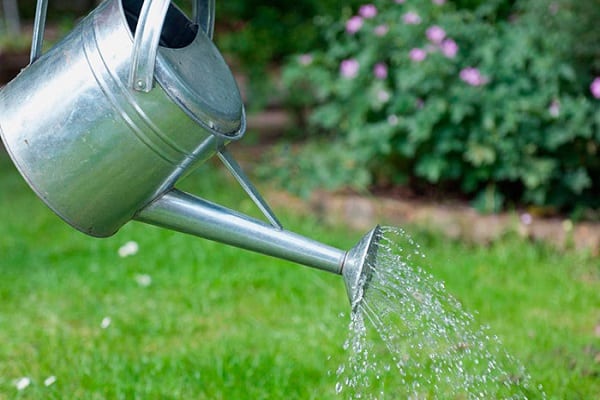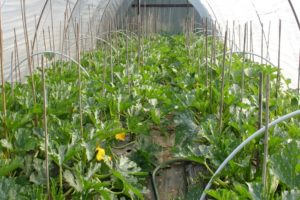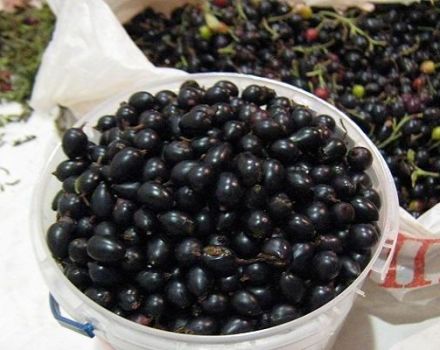How often and correctly to water zucchini in the open field
When growing zucchini, it is necessary to provide full planting care. One of the most important factors affecting the growth of a plant is watering the squash. This problem is especially acute in those regions where there is an arid or hot climate. There are several types of crop irrigation, each of which has its own distinctive characteristics.
Requirements for the level of soil moisture when growing zucchini
Water is an essential component of healthy plant growth and development. This is due to the fact that it is a constituent part of the cell sap, plasma. Also, water is responsible for distributing nutrients, regulating the temperature of the plant. In order for water to perform these functions in full, you need to know how often to water zucchini planted in open ground.

It is worth considering that zucchini react negatively not only to drought, but also to an excess of moisture in the soil, as this provokes damage to the root system due to a lack of oxygen. You also need to be aware that zucchini also react negatively to dry air. Its foliage begins to wither due to the active evaporation of moisture. That is why the method of watering the squash bed should be chosen based on the surrounding climate conditions.
Influence of excessive and insufficient moisture
Zucchini are very sensitive to lack of moisture during the first half of the growing season. It was at this time that the active development of the root system, the growth of the fruit mass, is observed. At this time, even a short-term drought can disrupt the process of growth and development.

The maximum amount of moisture is necessary for the full development of fruits in July and August. Providing regular watering during this period and before the fall in temperature begins, the likelihood of obtaining a large high-quality yield increases. Watering should be moderate, since not only a deficit, but also an excess of moisture negatively affects various plant systems:
- With a lack of moisture, the reproductive system contributes to the formation of a large number of male flowers, in the place of which fruits cannot develop in the future. An excess of water on this system does not have much effect.
- With a moisture deficit, the roots grow deep into the soil.And with an excess of water, the root system lies close to the surface layer of the soil. Due to the insufficient amount of oxygen in the ground, root hairs gradually die off.
- An excess of moisture greatly weakens the plant's immunity, it begins to be affected by diseases caused by fungi.
- With insufficient watering of the land in the heat, zucchini form small fruits. If you provide excessive watering, the level of sugar in the zucchini will decrease.
- If the crop is not properly watered, growth will be slow. If you provide excessive watering until the roots die off, the plant begins to actively grow, and then it is inhibited.
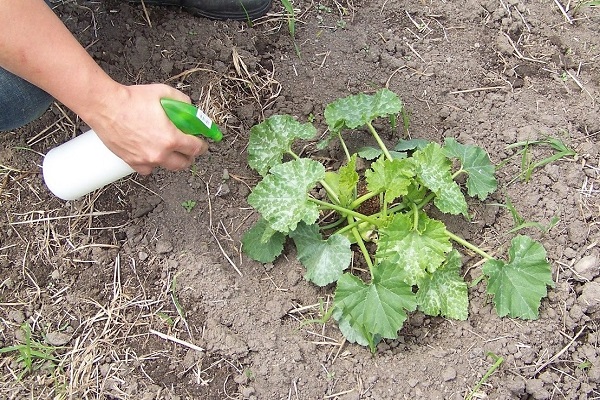
That is why, when growing zucchini, it is required to observe the optimal watering regime.
How to water zucchini outdoors in the country: 4 methods
Any methods of watering zucchini are based on three conditions:
- it must be timely;
- you need to water the plant regularly;
- watering should be selected based on varietal characteristics.
Also, before you understand how to water zucchini in the open field, you need to estimate the size of the plot.
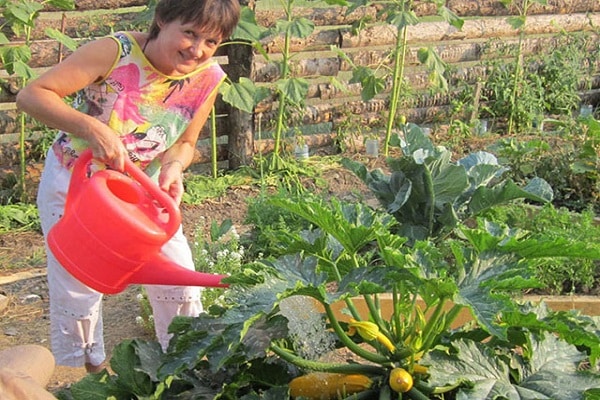
Method 1: bottle-based dosed irrigation system
One of the best options for watering zucchini outdoors is the use of metered watering techniques. It is provided with plastic bottles. In the collected container of large volume, the bottoms should be removed, and 4–6 holes should be made in the corks to ensure that the liquid flows out drop by drop. The best option is to puncture the plugs with an awl.
After the bottles are fully prepared, it is necessary to form a hole with a depth of 10-15 centimeters. You need to do it after 15–20 centimeters from planting. Next, the bottle must be buried upside down, tilted at an angle of 45 degrees. Then the bottles are filled with water.
It is worth considering that this method of watering during the period of fruit formation will not work, since the plant will not have enough moisture. At this time, additional watering will need to be provided.
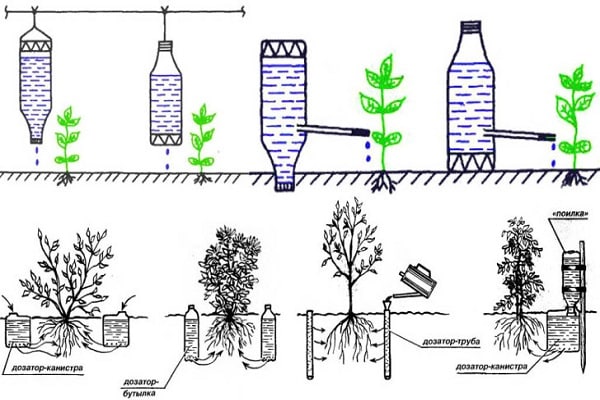
Method 2: using plastic containers
This method of watering zucchini also involves the use of plastic containers with a cut bottom. The difference is that the containers are not buried, but hung near the plant culture. At the same time, you do not need to make holes in the cork, you just need to unscrew it a little.
To prevent the soil from eroding the soil after watering the plant on the spot, this area must be covered with mulch or film. During the formation of fruits, flowering, fruiting, it is necessary to ensure that water drips under the root of the plant, and not on the green mass.
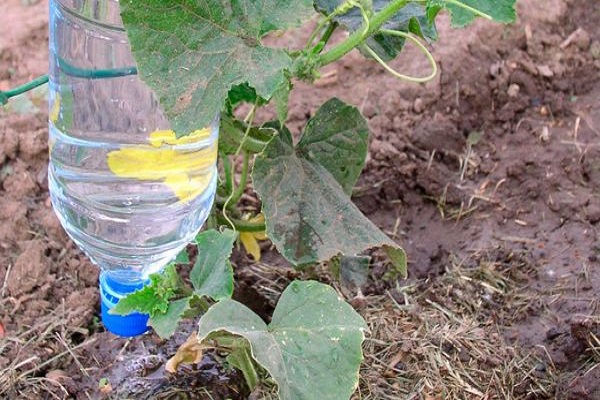
Method 3: multiple holes in the hose (spray irrigation)
It is fashionable to organize watering of zucchini with the help of a hose, in which holes are made along the entire length. In this case, the holes should be placed opposite the planted zucchini. The manufactured hose is dug in and connected to the water supply system. With the help of this technique, water enters the root of the plant, does not evaporate from the soil. With proper watering, the soil on the surface does not erode, but remains dry.
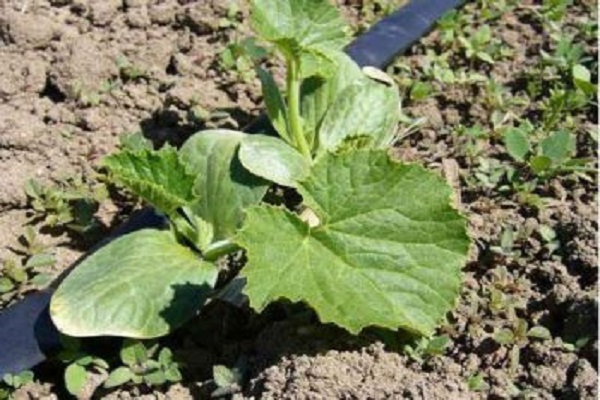
Method 4: watering with a "wick"
One of the most economical zucchini watering techniques is to use the "wick". As with growing zucchini in the open field moisten the soil:
- containers filled with water are placed every 2 meters of the ridge;
- a long cord is made of fabric;
- The tourniquet is dug in next to the ridge to a depth of 10–15 centimeters, while its ends sink to the bottom of the containers.
Gardeners recommend using this irrigation method because of its surface tension effect: the fabric is saturated with water and moves to the soil, giving moisture to the root system.
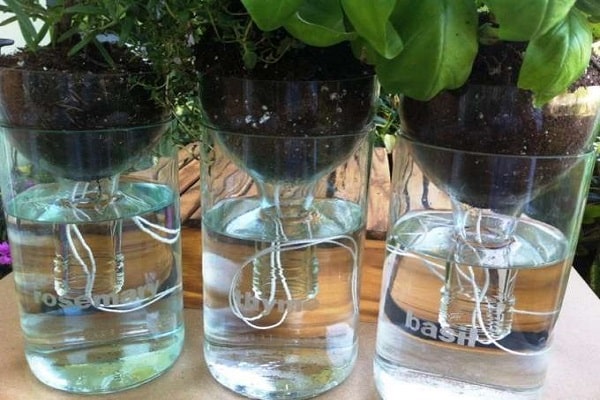
Watering methods for industrial plantings of marrow
Other methods are used to ensure watering of the commercially grown squash. Their choice is based on the following factors:
- on an affordable budget;
- on the relief of the land plot;
- on the goals and objectives of irrigation;
- on the availability of water.
There are 4 ways of watering industrial plantings of zucchini:
- drip;
- rain;
- gravity;
- subsoil.
Each of them has its own differences and features.
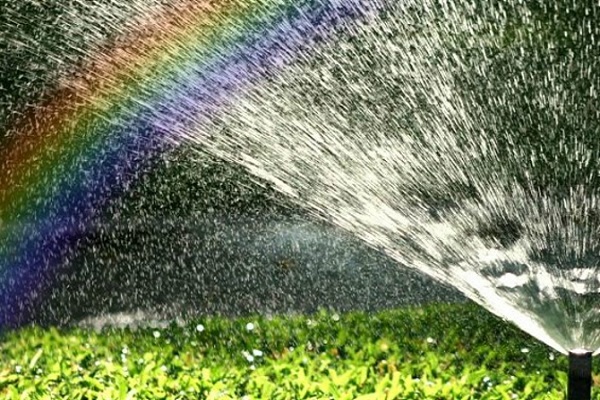
Gravity method
This technique is divided into two types: furrow, estuary. The first is to supply fluid to the crop between rows. And the second - in the complete flooding of the site. This method of irrigation is used for the full development of squash, not only for industrial agricultural plots, but also for summer cottages.
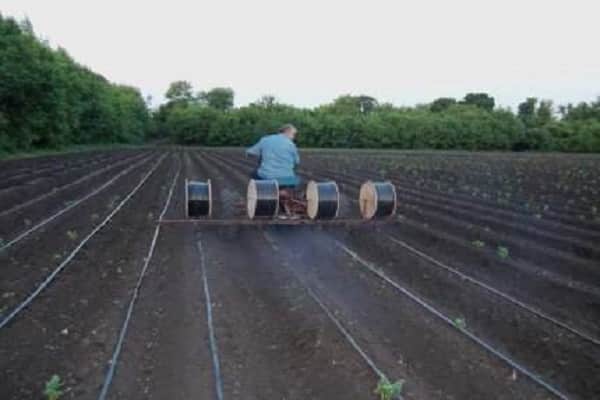
Sprinkling
This irrigation technique is mainly used by large companies involved in the cultivation of squash. It consists in the following: the liquid under the influence of the pump is sent through the pipes to the sprayers. Further, large droplets are formed.
One of the types of sprinkling is aerosol, fine-dispersed method. Specialized nozzles spray water to form a mist. This method is optimal in hot, hot weather.

Subsoil
There is another method of industrial irrigation on the site: subsoil. It consists in the following: metal or polymer pipes are placed in the aisles at a depth of 25 to 40 centimeters. Holes are made in them under the crop. Then water is started up through the pipes, supplying moisture to each plant. This method of watering is good because the leaves of the zucchini remain dry.

Drip watering zucchini
The use of a drip irrigation system is a high-tech and modern method of planting irrigation. To provide it, a polymeric drip tape is placed in the aisles. Then the rate of moisture intake is programmed and directed directly to the zucchini.
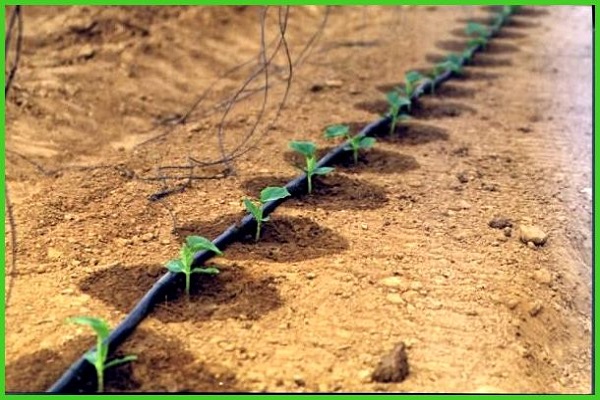
How much zucchini should be watered: watering rates
It is worth considering that the norms for watering zucchini in different regions of the country differ depending on climatic conditions. Irrigation should be carried out in volumes of 1500-7000 cubic meters of water per 1 hectare of plantings. In this case, the water volume is divided by 11 or more irrigations. The volume of water should be calculated taking into account the following factors:
- the level of soil moisture before the introduction of moisture;
- watering method;
- granulometric composition of the soil substrate;
- depth of the irrigated layer.

If there is a low level of precipitation in the area, it is necessary to add the maximum amount of moisture. In this case, it is imperative to evaluate the characteristics of the natural zone. The largest volume of water is required during flowering and fruit formation. It is necessary to irrigate the soil so that moisture flows 15–20 centimeters deep. Watering plantings is required in the afternoon.
From the moment the ovaries form on the plant culture and until the end of the harvesting work, watering the site needs to be done every week. Minimum: once every 10 days, while the HB level should not be allowed to drop below 80%, as well as its rise above 90%.
In the absence of maintaining these indicators, there is a deterioration in the supply of oxygen to the upper soil layer, an increase in the risk of crop disease. Therefore, watering should be carried out with an average ambient temperature of 15 degrees above zero. Plants should be watered with settled water in the morning or evening hours.
